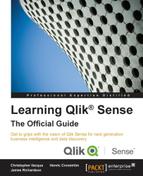Book Description
Get to grips with the vision of Qlik Sense for next generation business intelligence and data discovery
In Detail
The intuitive and powerful Qlik Sense analytics software allows anyone to engage in data discovery, to explore your data and find meaningful insights to empower your business. Qlik Sense lets you easily create personalized reports and visualizations, and reveal essential connections to show new opportunities from every angle.
Written by members of the Qlik Sense team, Learning Qlik® Sense is the official guide from Qlik to understanding and using their powerful new product. Benefit from the vision behind the development of Qlik Sense and get to grips with how Qlik Sense can empower you as a data discovery consumer. Learn how to create your own applications for Qlik Sense to customize it to meet your personal needs for business intelligence, and how to oversee and administer the Qlik Sense data architecture. Finally, explore utilizing Qlik Sense to uncover essential data, with practical examples on finding and visualizing intelligence for sales figures, human resources information, travel expense tracking, and demographic data discovery.
What You Will Learn
- Understand the vision behind the creation of Qlik Sense, and the promise that data discovery offers to you and your organization
- Get to grips with the life cycle of a Qlik Sense application
- Load and manage your data for app creation
- Administer your Qlik Sense system and monitor its security
- Visualize your data with Qlik Sense's engaging and informative graphing
- Build your own applications, from data import through to publication
- Optimize Qlik Sense for sales, human resources, and demographic data discovery
Downloading the example code for this book. You can download the example code files for all Packt books you have purchased from your account at http://www.PacktPub.com. If you purchased this book elsewhere, you can visit http://www.PacktPub.com/support and register to have the files e-mailed directly to you.
Table of Contents
- Learning Qlik® Sense The Official Guide
- Table of Contents
- Learning Qlik® Sense The Official Guide
- Credits
- About the Authors
- Acknowledgments
- About the Reviewer
- www.packtpub.com
- Preface
- 1. Why Develop Qlik Sense?
- 2. What is Data Discovery?
- 3. The Vision of Qlik Sense
- 4. Overview of a Qlik Sense Application's Life Cycle
- 5. Empowering Next Generation Data Discovery Consumers
- 6. Contributing to Data Discovery
- 7. Creating Engaging Applications
- Preparations and requirements
- Getting started with the app creation
- Loading your data
- Associative model assumptions
- Using Data model viewer
- Data connectors
- The user interface – sheets and visualizations
- The application library
- Best practices in data visualization
- Migrating applications from QlikView to Qlik Sense
- Publishing your apps
- Visualization extensions
- Summary
- 8. Administering Qlik Sense
- 9. Sales Discovery
- 10. Human Resource Discovery
- 11. Travel Expense Discovery
- 12. Demographic Data Discovery
- Index
